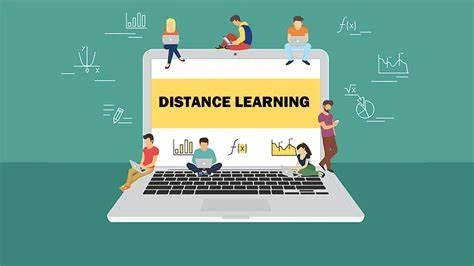The rise of distance learning programs has transformed the way people access education. With the advancements in technology and the growing demand for flexible learning options, these programs have become a popular alternative to traditional classroom-based education. Whether you’re a working professional, a stay-at-home parent, or someone looking to acquire new skills, distance learning offers a world of opportunities. This article provides an in-depth overview of distance learning programs, their benefits, challenges, and tips for selecting the right one.

Understanding Distance Learning
Distance learning, often referred to as online education, involves learning where students and instructors are separated by location. Unlike traditional on-campus education, distance learning allows students to access coursework, submit assignments, and interact with peers and teachers via online platforms. This method of learning eliminates the need for physical attendance, making education accessible to anyone with an internet connection.
Types of Distance Learning Programs
Distance learning comes in various forms to cater to different needs and learning preferences:
- Fully Online Degree Programs
Many universities now offer fully online degrees at the undergraduate, graduate, and doctoral levels. These programs allow students to complete their studies from any location while earning accredited degrees from prestigious institutions. - Professional Certificates and Diplomas
Short-term programs designed to help individuals gain specialized knowledge in fields such as business, healthcare, IT, and more. These are great for career advancement or acquiring new skills in a short timeframe. - MOOCs (Massive Open Online Courses)
Platforms like Coursera, Udemy, and edX offer free and paid courses from universities worldwide, allowing learners to take classes on subjects ranging from data science to creative writing. - Blended Learning
This is a hybrid model where part of the course is delivered online, and some portions require physical attendance. It’s useful for students who need hands-on experience but also want the flexibility of online education. - Self-Paced Programs
These courses allow students to complete work at their own speed, which is perfect for those who need flexibility due to personal or professional commitments.
Key Benefits of Distance Learning Programs
There are several advantages to choosing a distance learning program over traditional on-campus education:
- Flexibility and Convenience
One of the biggest benefits is the flexibility to study from anywhere, at any time. This allows students to balance their education with work, family, and other responsibilities. - Cost-Effective
Distance learning programs are often more affordable than their on-campus counterparts. Students also save on commuting, housing, and other associated costs. - Wide Range of Programs
With distance learning, students have access to a vast range of courses and degrees from institutions all over the world, offering more variety than local options. - Skill Development
Apart from academic knowledge, distance learning programs help students build valuable skills such as time management, self-motivation, and digital literacy. - Accessibility
Distance learning opens doors for people in remote areas or those unable to attend in-person classes due to physical limitations or personal obligations.
Challenges of Distance Learning
While distance learning offers flexibility, it also presents a few challenges that learners need to be prepared for:
- Self-Discipline Required
Distance learning requires a great deal of self-discipline and motivation. Without a structured schedule, students need to manage their time effectively to stay on track. - Limited Social Interaction
The lack of face-to-face interaction with classmates and instructors can lead to feelings of isolation for some students. Virtual discussions may not replicate the same experience as in-person engagement. - Technical Issues
Reliable access to technology and the internet is crucial for online education. Technical difficulties, such as poor internet connection, can interrupt the learning process. - Limited Practical Experience
Certain subjects, such as medical sciences or engineering, require hands-on experience, which may be difficult to simulate in an online environment.
How to Choose the Right Distance Learning Program
Selecting the right distance learning program is crucial to ensure that it aligns with your goals and needs. Here are some key factors to consider:
- Accreditation
Make sure the institution offering the program is accredited. This ensures that the program meets academic quality standards and that your degree will be recognized by employers. - Reputation and Quality
Research the program’s reputation by reading student reviews, success stories, and checking the credentials of the instructors. Opt for programs with high completion rates and positive feedback from alumni. - Course Format
Choose a program that suits your learning style. Some courses are self-paced, while others have fixed schedules and deadlines. Consider which format will work best for your personal and professional commitments. - Support Services
Look for programs that offer student support services such as academic advising, technical support, and access to library resources. These services can be vital to your success in an online program. - Costs and Financial Aid
Compare the costs of different programs and inquire about available scholarships, grants, or financial aid options. Many institutions offer payment plans to ease the financial burden.
Popular Platforms for Distance Learning
There are several established platforms where you can find reputable distance learning programs:
- Coursera – Offers courses and degree programs from universities like Yale, Stanford, and the University of London.
- edX – Provides free and paid courses from top institutions like MIT, Harvard, and Berkeley.
- Udemy – Specializes in affordable professional courses across a variety of industries.
- Khan Academy – Offers free educational resources and tutorials on subjects ranging from math to history.
- LinkedIn Learning – Focuses on skill-building courses for professionals, with certifications that can enhance your resume.
Conclusion
Distance learning programs are reshaping the educational landscape, offering unprecedented access to learning opportunities worldwide. While there are challenges to this mode of education, its flexibility, affordability, and accessibility make it a powerful option for students and professionals alike. Whether you’re looking to earn a degree, enhance your career, or simply learn something new, distance learning can provide the resources you need to achieve your goals.